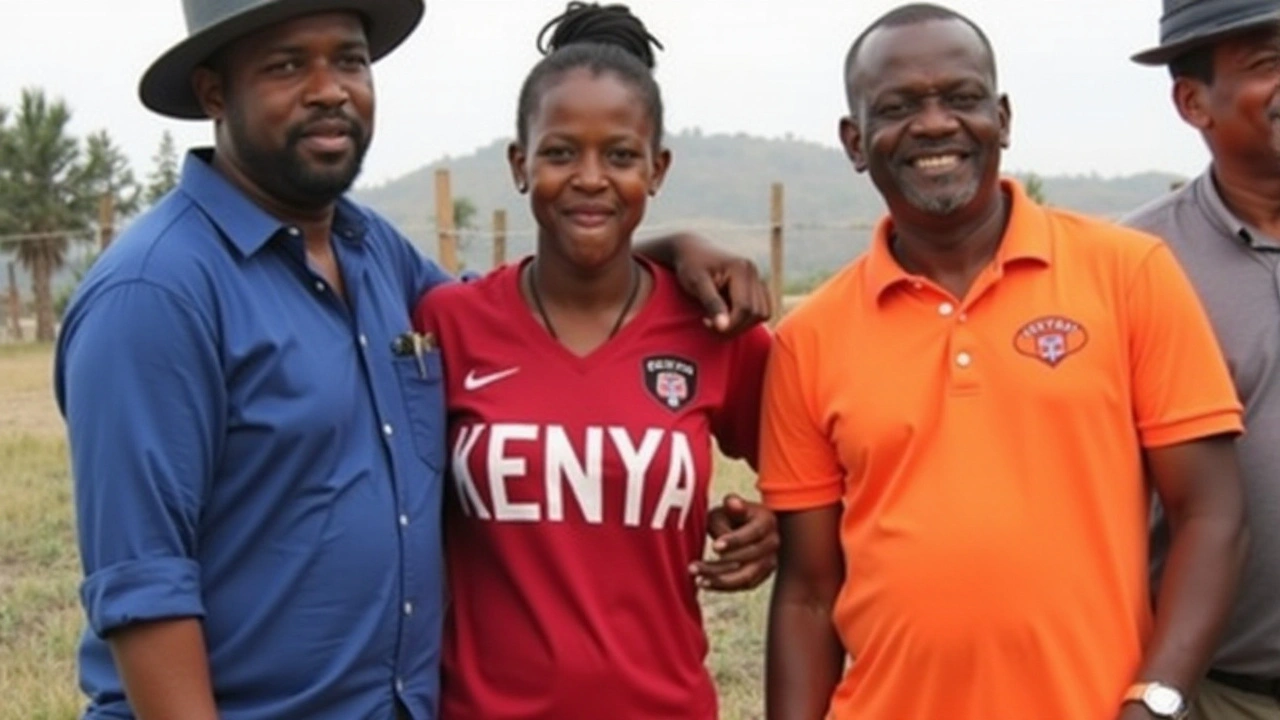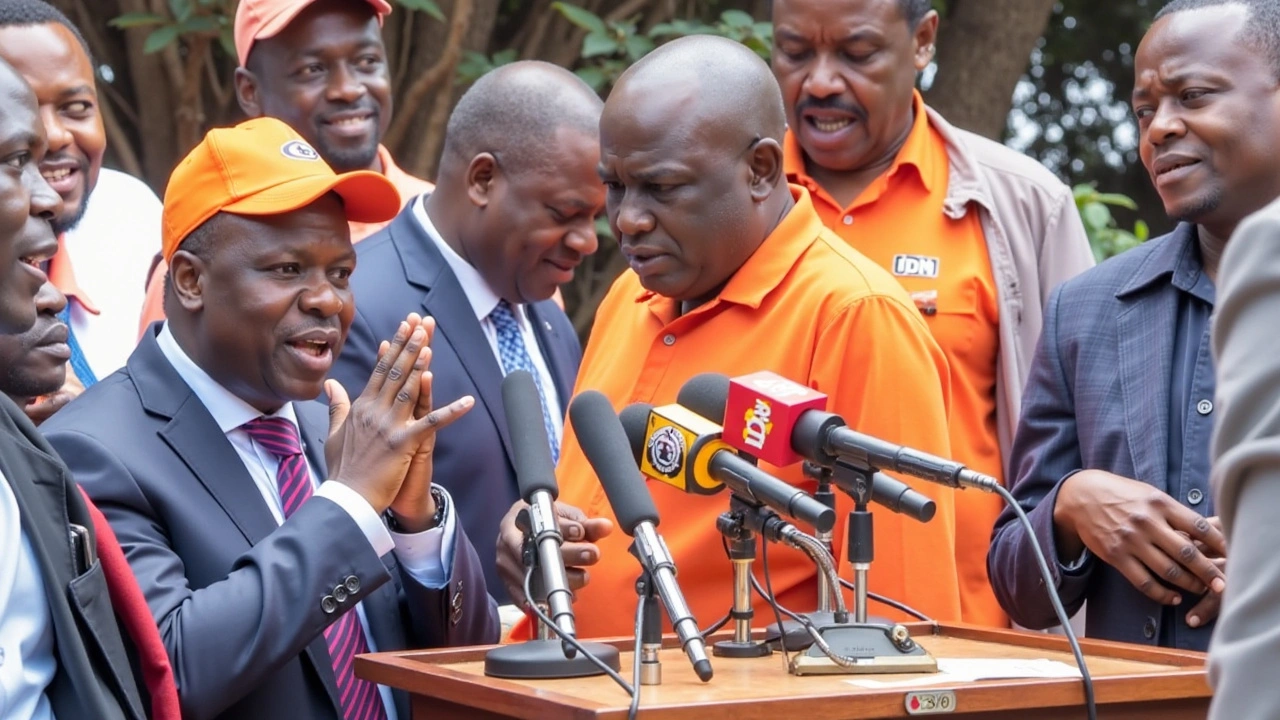The Battle for Leadership in Kenya's ODM
The Orange Democratic Movement (ODM), one of Kenya's most influential political outfits, finds itself at a pivotal crossroads as long-time party leader Raila Odinga prepares to vacate his position. This succession battle comes as Raila sets his sights on the African Union Commission (AUC) chairperson position, a role he aims to take on in February 2025. Given his prominent political stature, this transition marks a significant moment in Kenya's political landscape.
The departure of Raila, a former Prime Minister and a towering figure in Kenyan politics, necessitates a smooth and strategic transfer of power within ODM. The party's Central Management Committee (CMC) is slated to convene to decide who will step into Raila's formidable shoes. Several leaders have thrown their hats into the ring, eager to assume the mantle of leadership. Among the frontrunners are Governors Simba Arati of Kisii, James Orengo of Siaya, Gladys Wanga of Homa Bay, and Anyang' Nyong'o. In addition, ODM's Secretary General Edwin Sifuna is also in contention.
Candidates and Their Backers
The contest is a who's who of Kenyan political heavyweights, each with their own unique strengths and support bases. Simba Arati, known for his grassroots appeal and fervent oratory, has been a vocal leader in Kisii County. James Orengo, a seasoned politician and advocate, commands respect for his extensive legal and legislative experience. Gladys Wanga, the current Homa Bay County Governor, has emerged as a formidable force, especially among women leaders. Anyang' Nyong'o brings a wealth of experience from his tenure as Kisumu County Governor, while Edwin Sifuna has been effective as the party's Secretary General, known for his organizational acumen.
The transition has inevitably stirred a mix of tensions and alliances within ODM. Some party members have even called for a caretaker committee to oversee the party's operations over the next five months, awaiting the outcome of the AUC elections. Raila is anticipated to formally hand over party leadership during the National Delegates Convention (NDC) set for next month. This pivotal gathering will likely see heated debates and discussions, setting the stage for ODM's future trajectory.
Internal Party Dynamics
Interestingly, the sensitive nature of the succession discussion led to its deliberate exclusion from a recent meeting of ODM county chairpersons. This omission points to the delicate balance within the party ranks, with some leaders deeming it premature to openly discuss succession while Raila remains at the helm. Kakamega Governor Fernandes Barasa highlighted this sentiment, emphasizing the need for measured and respectful deliberation.
ODM National Treasurer Timothy Bosire sought to allay any concerns, affirming that the party's leadership structures are robust enough to handle the impending transition. Raila's recent appointments of Governors Arati and Abdulswamad Nassir, along with Vihiga Senator Godfrey Osotsi, as deputy party leaders, are viewed as strategic moves to ensure continuity and stability within ODM. These positions had been left vacant following the departure of former deputies Hassan Joho and Wycliffe Oparanya, who took up Cabinet roles in President William Ruto's government.

Support and Opposition
Support for various candidates is already coalescing among party members. Makadara MP George Aladwa has voiced his backing for James Orengo, citing his extensive experience and leadership capabilities. Conversely, Saboti MP Caleb Amisi is advocating for Edwin Sifuna, appreciating his organizational skills and vision for the party. Amisi has also floated the idea that Orengo could chair the Council of Elders, providing indispensable advisory guidance in Raila's absence.
Women politicians within ODM are showing strong support for Gladys Wanga. Recently elevated to the position of ODM national chairperson, Wanga enjoys significant backing from female leaders, marking an important shift towards gender inclusivity and representation within the party. This support base may prove crucial in navigating ODM through this period of transition.
Structural Changes on the Horizon
The ODM National Executive Council has given the nod to incorporating two new organs into the party's Constitution. These structural changes are part of Raila’s ongoing efforts to consolidate and stabilize the party as it transitions to new leadership. While the specifics of these organizational shifts are yet to be detailed, they underscore Raila's commitment to leaving ODM in a strong and resilient position.
As ODM stands on the threshold of a new era, the coming weeks will be critical in shaping its future direction. The leadership transition, the appointment of new deputies, and the support of key party factions will all play vital roles in determining who will carry the torch forward. For ODM and its supporters, this moment is not just about picking a new leader, but about ensuring the party's legacy and future success in Kenyan politics.
Looking Ahead
The focus now shifts to the imminent National Delegates Convention, where Raila is expected to officially pass the baton. This event promises to be a landmark gathering, not just for ODM, but for the entire Kenyan political sphere. The decisions made here will ripple through the country's political landscape, influencing dynamics in the run-up to the AUC elections and beyond.
In the final analysis, ODM's ability to manage this leadership transition smoothly will be a testament to its internal cohesion and strategic foresight. As Raila Odinga prepares to take on his new role on the continental stage, the party he leaves behind must prove itself ready to embrace new leadership while upholding the values and vision that have defined it over the years.
The weeks and months ahead will be crucial, not just for those vying for leadership, but for all who have a stake in ODM's future. The outcome of this succession battle will undoubtedly shape the political landscape in Kenya for years to come, making it a moment of profound significance for all involved.


Jane Vasquez
September 12, 2024 AT 20:40Oh great, another power‑play drama in ODM. As if we needed more theatrics, right? 🙄 Raila's exit is turning into a circus, and the clowns are already lining up for the big top. I can already picture the endless back‑room deals, the promises, the betrayal – all for that sweet smell of power. And let’s not forget the nationalist rhetoric that everyone pretends to love while secretly eyeing the title. 🎭
Hartwell Moshier
September 14, 2024 AT 09:46These succession talks are getting out of hand.
Jay Bould
September 15, 2024 AT 13:33Hello friends! Reading about ODM’s leadership shuffle feels a bit like watching a new season of a beloved series – full of intrigue and cultural twists. I’m curious to see how the different regional voices will shape the future of the party, especially with leaders like Arati and Wanga in the mix. It reminds me of the vibrant diversity we celebrate back home, where every community brings its own flavor to the table. Let’s hope the process stays inclusive and respects the rich tapestry of Kenyan politics.
Mike Malone
September 16, 2024 AT 17:20Throughout the annals of political organization, it becomes evident that the transition of leadership within a dominant party such as the Orange Democratic Movement is not merely a matter of personnel replacement, but rather a profound reconfiguration of ideological stewardship and strategic direction. The constitutional mechanisms that govern the appointment of new party officials must therefore be scrutinized with both rigor and impartiality, ensuring that the emergent leadership aligns with the foundational principles that have underpinned ODM’s historic ascendancy. Moreover, the interplay between regional allegiances and national aspirations presents a delicate equilibrium; neglecting either facet could precipitate factionalism that erodes the party’s cohesion. It is incumbent upon the Central Management Committee to balance the aspirations of seasoned veterans with the innovative vigor of emerging leaders, fostering a synthesis that neither alienates veteran constituencies nor suppresses fresh perspectives. In this regard, the inclusion of figures such as Governor Simba Arati, with his grassroots resonance, alongside the seasoned legislative acumen of James Orengo, illustrates a potential confluence of local authenticity and parliamentary expertise. Simultaneously, the rising prominence of women leaders like Gladys Wanga signals an evolving gender paradigm within Kenyan politics, a development that should be reinforced rather than merely tokenized. The weight of responsibility also extends to the party’s organizational architecture; the proposed constitutional amendments introducing new organs must be evaluated for their capacity to augment, rather than complicate, decision‑making processes. If the reforms are implemented with transparency and foresight, they could fortify ODM’s institutional resilience during this pivotal interregnum. Conversely, any perception of opportunistic restructuring could embolden dissent and undermine public confidence. As Raila Odinga transitions to a continental platform, his legacy will inevitably be measured by the sustainability and adaptability of the party he nurtured. Therefore, the forthcoming National Delegates Convention stands as a crucible, testing not only the tactical competence of prospective leaders but also the philosophical coherence of the party’s vision for Kenya’s future. In sum, the succession battle is an intricate tapestry woven from strands of personal ambition, ideological continuity, and structural evolution, each demanding careful consideration to safeguard ODM’s enduring relevance.
Pierce Smith
September 17, 2024 AT 21:06Reading through the succession buzz, I can’t help but hope for a collaborative spirit to emerge. It’s essential that all factions feel heard, and that the process isn’t reduced to a zero‑sum game. If the party can channel its energy into constructive dialogue, the outcome could strengthen ODM’s platform for everyone. Let’s keep the conversation respectful and focused on shared goals rather than division.
Abhishek Singh
September 19, 2024 AT 00:53Wow another guru thinks he knows everything about politics lol still waiting for actual action
hg gay
September 20, 2024 AT 04:40Hey folks 😊 I see a lot of passionate opinions flying around, and that’s a good sign that people care deeply about ODM’s future. It’s understandable to feel strong emotions when leadership changes are at stake, but remember that every voice adds value to the collective conversation. Whether you back Arati, Orengo, Wanga, Nyong’o, or Sifuna, there’s an opportunity here to shape a more inclusive and forward‑thinking party. Let’s keep supporting each other, share insights, and maybe sprinkle in a few emojis for good vibes! 🌟